“From the 19th of March to the 29th of March”
Beginning of our trip being 3 in the van
As soon as we say goodbye to Valentin’s parents, we pick up Rodolphe, his childhood friend. .
These last two weeks of adventures for 3 in Tanzania have been very busy. We have been on the road and doing a lot of activities. Each day, we slept in a different place, except in Lushoto where the rain convinced us to stay one more night. Rodolphe adapted very quickly to our life in a 4×4 van on the roads of Tanzania. As soon as he returned to France, he was already looking for his future car. In Uyo, the space for three people is a bit limited but still adapted. We let him use the bottom room, inside. Once converted into a bed, the bench seat can hold his six feet. As for us, the roof tent serves as the upper bedroom. So, at night, it’s every man for himself.
Bagamoyo
After spending the night in the car park of the airport gas station waiting for Rodolphe, we decide to leave Dar Es Salaam to find a quiet spot on the Indian Ocean. We find a nice spot at the end of a sandy road, not far from a small fishing village. We meet Abdel and Youssouf. They are very curious and observe us from a distance. They spy on our every move, however commun. Then they introduce themselves and exchange a few words in Swahili. Unfortunately, the conversation stops quickly. Our level in this language is still very limited.

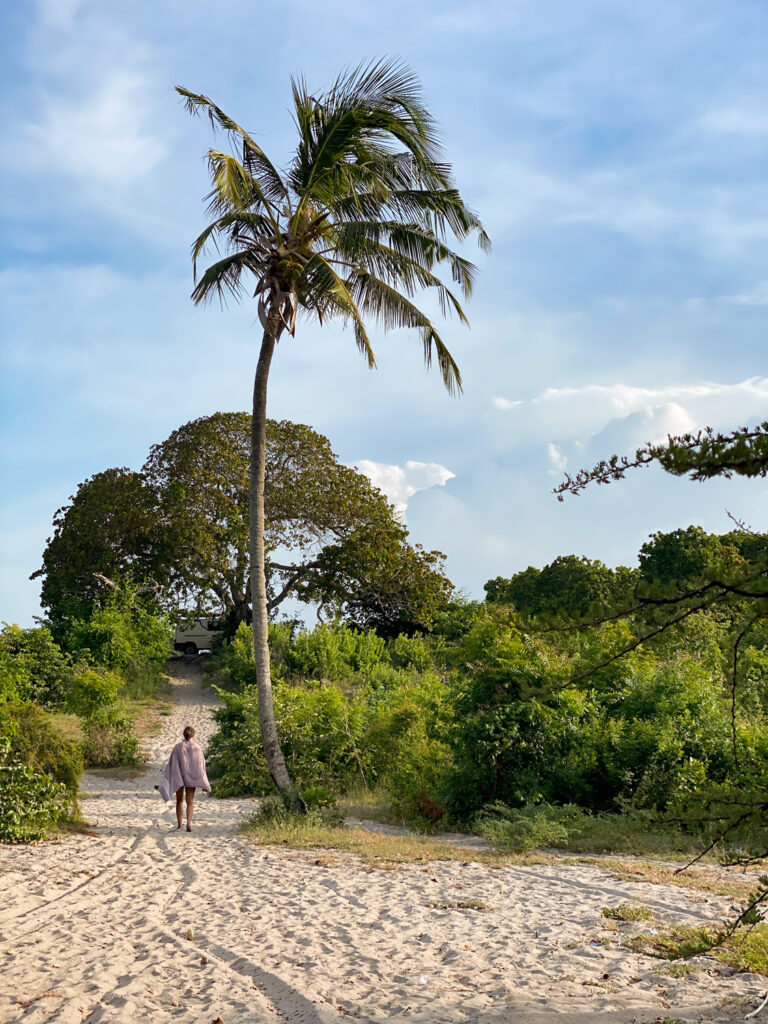
The next day, before leaving, we offered to play a card game to our new friends. We know that getting them to understand the rules will not be easy, so we choose the card game that seems easiest to us: President. Armed with our translator, we start to explain the cards and the purpose of the game. After about ten minutes of explanations, we decide to start the game. Although we don’t speak the same language, we manage to understand each other thanks to the signs and a few words learned on the spot. Abdel and Youssouf do not win the game but they are happy to share this moment with us.


We leave for the town of Bagamoyo, our last destination on the coast before heading inland. This town is infamous for being an important place during slavery. There are many colonial houses that are now in ruins. At the port, we stock up on fish. The fishing is fresh, the boats have returned to port shortly before and we can find octopus, squid and fish of all sizes. For this evening, we are looking for tuna. They are delicious and local! We choose two nice tuna of modest size before heading back to the road. We head north towards Kilimanjaro, which we will see for the first time a few days later. On the road there is a succession of maize fields. It is a plant that grows very well in Africa. It has been imported as a solution to the famine. We also pass many school children returning from their lessons. They all wear a nice uniform whose colour changes according to the school. We often find blue, green and burgundy red.
Before nightfall, we start looking for a place to sleep. The first road we see is still too close to the highway. We are too visible and the traffic is noisy. A few kilometres further on, we find a small dirt road thanks to the satellite view on Google Map. After passing through a village, we find a suitable spot. A recess in the grass under a tree with just enough room for Uyo and our table.
As soon as we took our chairs out that a local came to us. Emmanuel is the owner of this land and lives a little further away. He offers us to sleep near his house, in the middle of his banana field, which we gladly accept. Emmanuel has two children, one of them is 25 years old, David, who now lives in another part of Tanzania.





The night is full of stars, we can even see the Milky Way. The constellations are different in the southern hemisphere. We do not see the famous Ursa Major but Cassiopeia, an archer ready to shoot his arrow. The night is soft and quiet. Only the sound of banana leaves being shaken by the breeze can be heard. They lull us to sleep.




From the Lushoto mountains to the Kilimanjaro
We drive towards Moshi. The road is long, it is hot. After the heat of the coast, we are longing for coolness. The Lushoto mountains overlook the road heading north. We decide to make a small diversions to camp up there with Uyo. This time, we find some comfort in the campsite of the Irente farm. Perched in the mountain, the village of Irente and its surroundings offer many views on the plain which extends as far as the eye can see.





Luckily, our evening walk takes us to the spot that is well oriented to watch the sunset. One of the most beautiful since we left South Africa. Pascal, a local guide, comes to chat with us. He wants to sell us a dream by showing us Kilimanjaro in the distance. He takes advantage of our ignorance because the next day we learn that Kilimanjaro is not in that direction as confirmed by our GPS. We enjoy the mountain and the beautiful landscapes to hike a bit. After two days on the road, our legs need to stretch and our body needs to get back to work. For our walk, we are not alone. The village children, just finishing school, accompany us. Curious but not reassured, they follow us at a distance. They play hide-and-seek with the camera while coming back regularly to be taken. When Lauréne shows them the pictures, they ask for more!





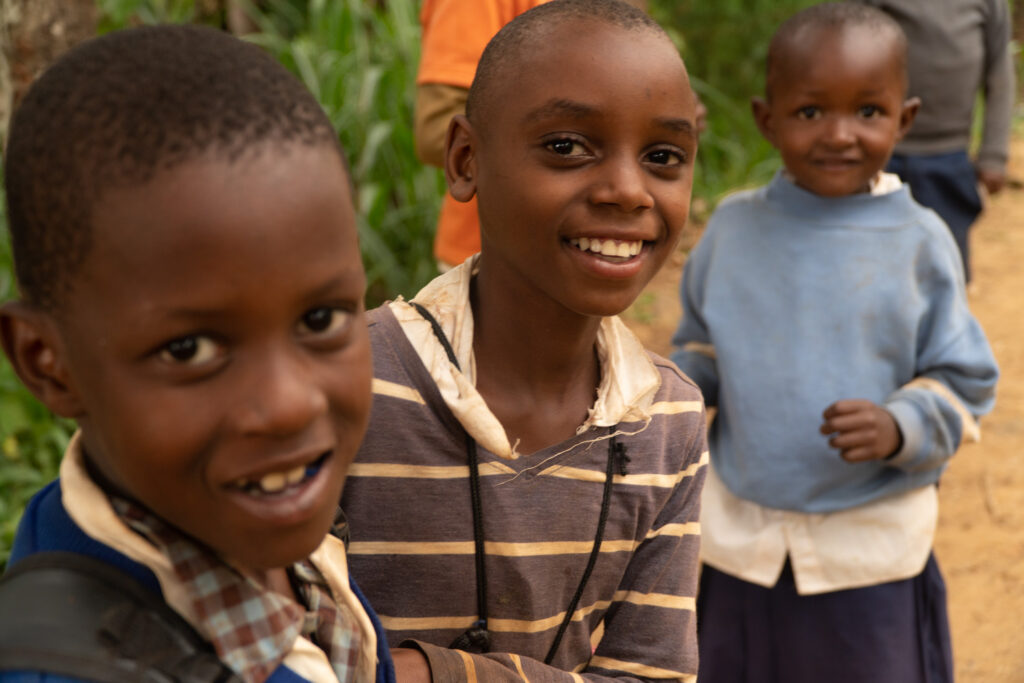

At the camp, between two bites of our homemade burger, we hear strange bird calls. None of us recognizes these sounds. And for good reason, in the morning the unknown animal appears to our eyes flying from one tree to another. It is a black hornbill toucan with bluish hues and a very large beak topped by a sort of helmet.



The rain pushes us to stay an extra night at the farm. We like being here, it is a really nice place. We leave the next day with the aim of getting a view of Kilimanjaro, the real one this time, at our next camp. The road is getting drier and drier. The savannah takes shape before our eyes. The sun-yellowed grass stretches as far as the eye can see and in some places bushes and small trees offer shelter. It is not easy to find shade for our picnic.
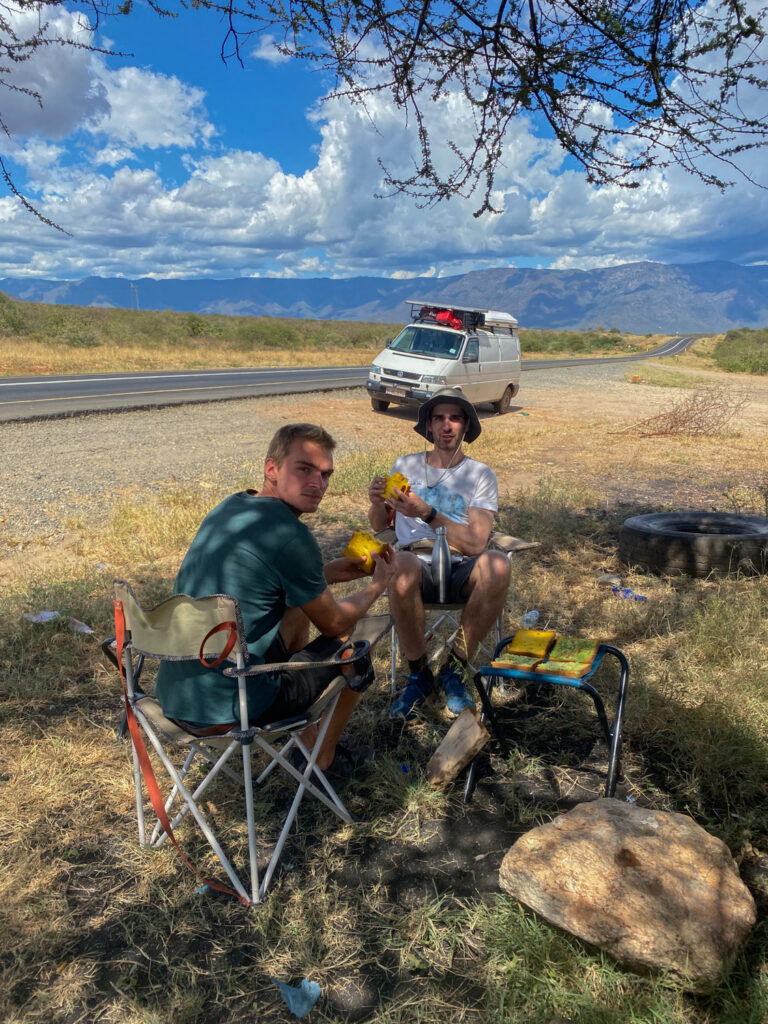

While driving, we spotted several fires in the distance that form glowing clouds. Nevertheless, they seem very far away. We settle down for the night in the nature at the bend of a small road. The place is wild, on the edge of a river with a view on Kilimanjaro. We admire the landscape. We are comfortable and relaxed. But not for long. As we sit down to eat, Rodolphe notices that the fire is getting closer. It is still quite far away, but we can hear it and from the roof of the van we can even see the flames. So the discussions during the meal are about the reason for the fire, its potential danger and our “escape plan” just in case. We scare ourselves, we reassure ourselves. In any case, we keep an eye on its direction and its spread.

As night falls, we see the dark sky turn red from the burning of the bushes. Finally, little by little, it seems to fade away until it almost disappears. We can go to bed and sleep soundly. Before going to sleep, we hear hippos grunting in the river next to us. Here too, we have to keep an eye on them when we get out of bed.







We arrive in the Arusha region. The city centre, which is our destination, is not far away, probably less than an hour. Despite the grilled corn we bought on the road, we are getting hungry. We look for a shady spot on the side of the road for lunch. From time to time small roads go off to the right or left. But with the speed, it is not easy to judge if they are good to stop on. Finally, we take a road that goes off to the left. A sign announces a school. The road is quite wide with nice trees aroynd. We sit down in the shade of the trees on our little camping chairs. The leftovers from the previous day are still good. They even attract the curiosity of a velvet monkey, also known as a black mask monkey.
At coffee time, we meet Justin. He was passing by on his motorbike and stopped to chat. He is a trained tour guide and likes to talk to travellers in Tanzania. He tells us that this road, taken by chance, leads to a waterfall near his village. He offers to take us there and eventually take a tour of the village. And why not stay there for the night if we want. Usually, he gets paid to guide visitors. For us, he has no price. We can give whatever we want. We warn him of our low budget. We prefer to announce the colour in advance so that he is not disappointed. Hakuna Matata, no problem for him.



We go to the waterfall. Justin gets on his motorbike and we follow him to the entrance of the village. To reach the waterfall, you have to know the place. We cross the garden of a house. The lady of the house is in the yard. With her hands in a basin, she stops rubbing her laundry to welcome us. Behind her banana plantation, a steep path leads to the river and the waterfall. After a morning’s drive under the Tanzanian sun, we jump into the water without hesitation. We swim in the shallow water. We feel alive again. Both relaxed and invigorated by the cool water that falls about fifteen meters.
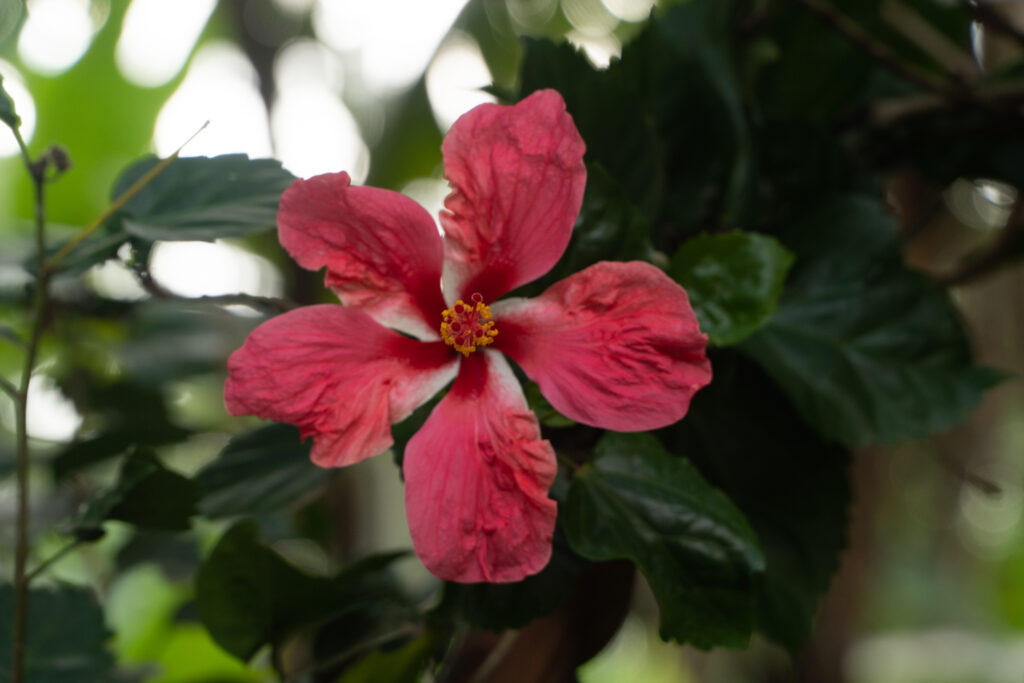


We follow Justin through the village, now full of energy. The water from the mountain is a blessing for the inhabitants. The crops are green and many varieties of plants are useful to them. Justin is happy to educate us about this. We did not remember all the names but some of their benefits, especially medicinal: healing, for toothache, for strong smelling armpits, etc. They all have a very specific function. There is even a symbolic plant against violence. It is used to ask for peace and to start reconciliation talks. After a tour of his house to meet his beautiful wife and two small children, we end the day in the village bar. When Justin tells us about the local banana beer, we all want to try it. We share two different ones. One is close to cider in taste, the other is sour and reminds us of sour beers often made from fruit. At 12%, they are quite strong. We take one for now and two to go for another day.
The sun is getting closer to the horizon, it’s time to settle down for the night. Justin suggests we come and park in front of his house. Uyo takes us through the small dirt roads usually used by motorbikes and pedestrians. We barely have enough room to pass between the hedges in the alley leading to Justin’s house. The next day, we’ll have to go backwards, but for now, we’re very comfortable. A few neighbours wave to us and then go on their way. The local children watch us with curiosity before going home.
In the morning, Justin insists on inviting us to his house for breakfast. His wife has prepared fresh hot milk from their two cows. He brings some bread to dip in and some sugar. The sofa is big enough for the three of us to sit on in front of the coffee table. On the left Justin sits in his armchair and turns on his little television. Before leaving we exchange contacts. With the house he is building for his family, he does not yet have the budget to buy a smartphone. Nevertheless, he can read his e-mails at the local cybercafé.


In the Maasaï land
Here we go for 4 days of dirt roads. The last time we did so many kilometres off road was in Mozambique (Article 7 – From Pomene, to the red dunes of Vilanculos). We are going to the region where the Maasai tribe live. Settled in a desert region north of Tanzania and south of Kenya, they have kept their cultures and customs. The men look after the herds of goats and cattle while the women stay in the village. Nomads, they sometimes travel for miles to find fresh grass for their herds.














They live in a very arid environment, the living conditions are not easy. This is why the Maasai region has remained very unspoilt. At the time of colonisation, the dryness of these large areas naturally repelled the settlers. Today, the Maasai are in competition with national parks and conservation areas. The government has a policy of expansion to both protect and monetise nature. In some areas, the Maasai are no longer allowed to graze their herds at the cost of a very high fine. If they cannot pay the fine, the animals are confiscated.
As we get closer to the volcano and Lake Natron, the scenery is unique. We have the feeling of being very small in the middle of the powerful nature. The volcanoes have formed the landscape that is in front of us. Numerous craters and volcanoes contrast with the vast plains.



The highest volcano in the region, Ol Doyno Lengai, is over 2900 metres high. It is the only active volcano in Tanzania. Its last major eruption was in 2008. It is considered the sacred mountain by the Maasai tribes. Its lava, which solidifies into limestone, is the coldest in the world. When it erupts it takes on a grey-white colour as opposed to the usual red magma. This is due to its temperature, which is “only” around 500°C. Scientists call it “cold” lava.
We decide to climb this symmetrical cone to the crater. The climb is done at night to avoid the heat and to have a chance to observe the sunrise at 6am. As for us, we are up at 1.30am, the beginning of the climb is planned for 3am. We pack up at the camp and head up into Uyo with our guide Zephania. At night on the trail leading to the foot of the volcano, the LED spotlights of Uyo are very useful. A few slices of peanut butter and we are off. Equipped with our headlamps, we climb 1700m in one go. The path follows the topography of the volcano. It climbs straight up and steeper. The smell of sulphur intensifies as we approach the summit. It fills our lungs with activity. The day breaks when we reach the crater. The fog is thick, we have no visibility of the sun, nor even of the moving lava at the heart of the crater. Nevertheless, we can hear the low sound of its activity. Near the summit it is cold. We warm our hands over a pocket of hot air coming from the crater.
We quickly descend the volcano, but not fast enough to get past the fog that follows us. It is only towards the end that the view opens up. It is just breathtaking. The verdant volcano and its newest black lava flows spill out onto the plain to Lake Natron on the horizon. The Rift Valley mountains encircle the whole thing. From our vantage point, we see only nature as far as the eye can see. Not a single house, not a single road. The only small white spot of “pollution” is our Uyo below. It takes us longer to descend than to climb, bewitched by the extremely photogenic view.







Proud of our ascent, we take a well-deserved shower at the guides’ camp, who graciously welcome us. A quick trip to the village and we are back on the long roads of ash, sand and rock in this arid environment. An hour later, we leave the main track to approach a crater. Its name, Shimo la Mungu, means God’s Step. This natural basin is breathtaking. In the middle of the dry plain, a cliff drops below ground level. At the bottom of the crater, the vegetation grows better. The Maasai send their herds to graze on the fresh grass. We arrive at the site an hour before nightfall. It is already late and we meet a lot of Maasai returning with their herds to their nearby village. We try to exchange a few words but communication is complicated. Our interlocutors speak only Maa. English and Swahili are not spoken in these remote places.





Laurène start preparing the meal under the curious gaze of three children, two young girls and a little boy. Living in a region too arid to grow anything, they don’t know the food I use. Tonight we eat crepes. I prepare the dough and a vegetables mix that will garnish them. While cooking, I offered them to taste some green peppers. It is not a great success. As soon as they put it in their mouth, it is spit out. A taste perhaps too bitter for them, who only eat meat, milk, blood and sometimes rice. Nevertheless, sugar crepes are a big hit. Only few people can resist the sweet taste.

The sky is beautiful this evening. Far from any light pollution, we can see all the stars clearly. I take my camera out again for some more night shots. In the distance, we hear a motorbike approaching. It is a young man who leaves his village at a late hour to reach the big city. Unlike the people in his village, he has learned English and speaks it perfectly. The main language of the Maasai is Maa, of which we have learned a few words thanks to our meetings:
- Ashe Naling = Thank you very much
- Supai / Ipa = Hello, how are you? / Good
- Sidai = Beautiful
- Engarre = Water
In the early morning, the light of day gently awakens us. Then we hear discreet voices. A woman and two children have settled down several dozen metres from Uyo to lay out jewellery on the ground on cloth. Laurène is the first to climb down the ladder from the roof tent. She meets Maria. Her daughter, whom she had met the day before, informed her that we were interested in buying some pretty Maasai jewellery. She brought her creations and those of other women in the village. The bracelets, earrings and necklaces are some of the most beautiful we have seen in Tanzania. In the Maasai culture, women are not allowed to leave the village. They make beaded jewellery which is then sold on the markets. These beads were formerly made from bones, seeds, plants, minerals or porcupine spines. These products are easily found in this region. There are still some bracelets made from these natural pieces, but the majority of beads now come from elsewhere.


Several times Maria tells us that it will rain soon, but since we are still a bit sleepy, we do not take this information in. A few minutes later, we find ourselves in the pouring rain. We all pack up our stuff and us 6 take shelter in our van. The hunger starts to make itself felt, we have not yet taken the time to have breakfast. So we take out the bread and peanut butter to treat everyone. The youngest one only makes a mouthful of it!


Once the sky has calmed down, Maria suggests we visit her village and her house, which she calls Boma. We discover her small village composed of a dozen huts. She lives there with her family. The village is surrounded by brambles like natural barbed wire to protect their herds from predators at night. The huts built by the women are divided into several small rooms, with two huge beds that accommodate both children and adults.




Our visit to the land of Maasai was a very nice experience but unfortunately too short. We would have liked to stay longer, to sleep near the village and to learn to live at their pace. Even if it is complicated to communicate without a common language, having a longer and deeper exchange allows us to break the clichés and preconceptions. On our side, not seeing the Maasai as an exotic tribe that is cool to photograph and on their side not seeing us as white tourists who only have money to bring them. We were lucky to meet Maria who invited us into her boma, overcoming the prejudices.



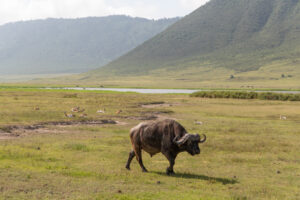

Faboulus pictures in very different lands. Green area in 🍌 plantations and dry area with splendid Massaï persons. Very good trip !
thank you very much for the information
Waouh great experience ! Ashe Naling
Massai are very proud of their culture, a beautiful connection to the world !
Tanzania one of the greatest destination in Africa !!